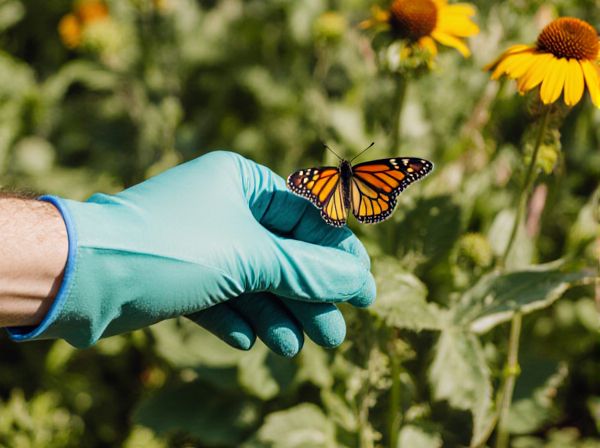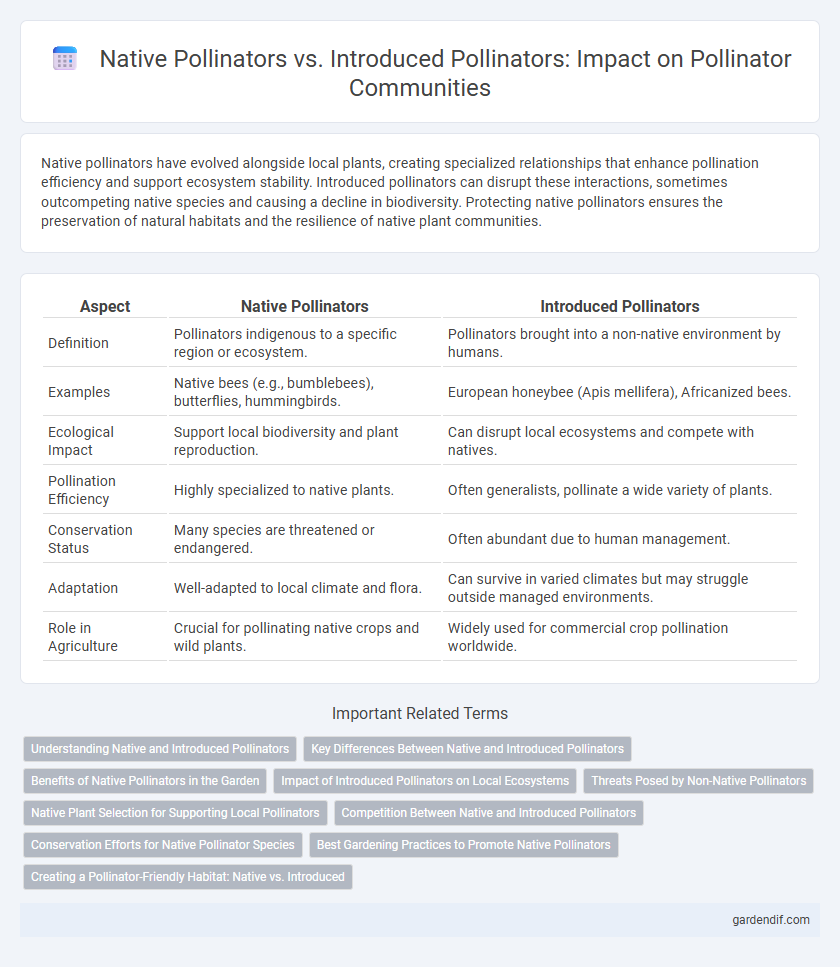
Native pollinators vs introduced pollinators Illustration
Native pollinators have evolved alongside local plants, creating specialized relationships that enhance pollination efficiency and support ecosystem stability. Introduced pollinators can disrupt these interactions, sometimes outcompeting native species and causing a decline in biodiversity. Protecting native pollinators ensures the preservation of natural habitats and the resilience of native plant communities.
Table of Comparison
| Aspect | Native Pollinators | Introduced Pollinators |
|---|---|---|
| Definition | Pollinators indigenous to a specific region or ecosystem. | Pollinators brought into a non-native environment by humans. |
| Examples | Native bees (e.g., bumblebees), butterflies, hummingbirds. | European honeybee (Apis mellifera), Africanized bees. |
| Ecological Impact | Support local biodiversity and plant reproduction. | Can disrupt local ecosystems and compete with natives. |
| Pollination Efficiency | Highly specialized to native plants. | Often generalists, pollinate a wide variety of plants. |
| Conservation Status | Many species are threatened or endangered. | Often abundant due to human management. |
| Adaptation | Well-adapted to local climate and flora. | Can survive in varied climates but may struggle outside managed environments. |
| Role in Agriculture | Crucial for pollinating native crops and wild plants. | Widely used for commercial crop pollination worldwide. |
Understanding Native and Introduced Pollinators
Native pollinators, such as native bees and butterflies, have evolved alongside local plants, ensuring efficient and specialized pollination crucial for ecosystem stability. Introduced pollinators, like the European honeybee, can enhance crop pollination but may compete with native species and disrupt established plant-pollinator relationships. Understanding the balance between native and introduced pollinators is essential for biodiversity conservation and sustainable agricultural practices.
Key Differences Between Native and Introduced Pollinators
Native pollinators, such as bumblebees and butterflies, have co-evolved with local plants, creating specialized relationships that enhance ecosystem stability and biodiversity. Introduced pollinators like the European honeybee often exhibit generalist foraging behaviors, which can outcompete native species and disrupt pollination networks. These differences impact plant reproduction efficiency, habitat health, and the conservation of native pollinator populations.
Benefits of Native Pollinators in the Garden
Native pollinators contribute significantly to garden health by supporting local plant reproduction and maintaining biodiversity, as they have co-evolved with indigenous flora for optimal pollination efficiency. Their adaptation to the native ecosystem ensures resilience to local pests and diseases, reducing the need for chemical interventions. Encouraging native pollinators enhances ecosystem balance and promotes sustainable garden practices, fostering a thriving environment for native wildlife.
Impact of Introduced Pollinators on Local Ecosystems
Introduced pollinators, such as non-native honeybees, often compete with native pollinators for floral resources, leading to reduced food availability and disrupted foraging patterns. They can also introduce novel pathogens and parasites, negatively impacting indigenous pollinator populations and biodiversity. This competition and disease transmission cause shifts in pollination networks, potentially diminishing plant reproductive success and altering ecosystem stability.
Threats Posed by Non-Native Pollinators
Non-native pollinators often disrupt local ecosystems by outcompeting native species for resources, leading to declines in native pollinator populations. They can introduce unfamiliar pathogens and parasites that native pollinators lack resistance against, exacerbating health threats. The alteration of native plant-pollinator interactions by introduced species can reduce plant biodiversity and destabilize ecosystem services essential for agricultural productivity.
Native Plant Selection for Supporting Local Pollinators
Native pollinators thrive best when paired with native plant species that provide appropriate nectar and pollen resources adapted to their life cycles, promoting biodiversity and ecosystem resilience. Selecting native plants supports the specific habitat requirements and foraging behaviors of local pollinators, such as certain bee, butterfly, and bird species, unlike introduced plants that may not meet these ecological needs. Prioritizing native plant selection aids in sustaining native pollinator populations, enhancing local food webs and pollination services critical for native flora reproduction.
Competition Between Native and Introduced Pollinators
Competition between native and introduced pollinators affects biodiversity and ecosystem stability, as introduced species often outcompete natives for floral resources. Native pollinators typically have specialized relationships with local plants, while introduced pollinators can disrupt these interactions by monopolizing nectar and pollen. The decline of native pollinator populations due to competition can lead to reduced pollination efficiency and loss of native plant diversity.
Conservation Efforts for Native Pollinator Species
Conservation efforts for native pollinator species prioritize habitat restoration, planting native flora, and reducing pesticide use to support their populations. Native pollinators, such as bumblebees and solitary bees, exhibit specialized relationships with local plants, making their preservation crucial for ecosystem stability and agricultural productivity. Protecting native pollinators also mitigates risks linked to invasive introduced species, which can disrupt native ecosystems and reduce biodiversity.
Best Gardening Practices to Promote Native Pollinators
Promoting native pollinators in gardening enhances local biodiversity and supports resilient ecosystems by providing habitat-specific plants that native pollinators rely on for food and nesting. Best gardening practices include planting diverse native wildflowers, avoiding pesticide use, and creating natural habitats such as bee hotels and undisturbed soil patches. Establishing these conditions helps sustain native pollinator populations, which are often more efficient and adapted to regional flora compared to introduced species.
Creating a Pollinator-Friendly Habitat: Native vs. Introduced
Creating a pollinator-friendly habitat requires prioritizing native pollinators like bumblebees, solitary bees, and butterflies, as they are well-adapted to local plants and climates, ensuring effective pollination and ecosystem balance. Introduced pollinators such as honeybees provide valuable services but may compete with native species for resources and disrupt ecological networks. Selecting native flora, minimizing pesticide use, and maintaining diverse habitats support the resilience and health of native pollinator populations.
Native pollinators vs introduced pollinators Infographic

 gardendif.com
gardendif.com